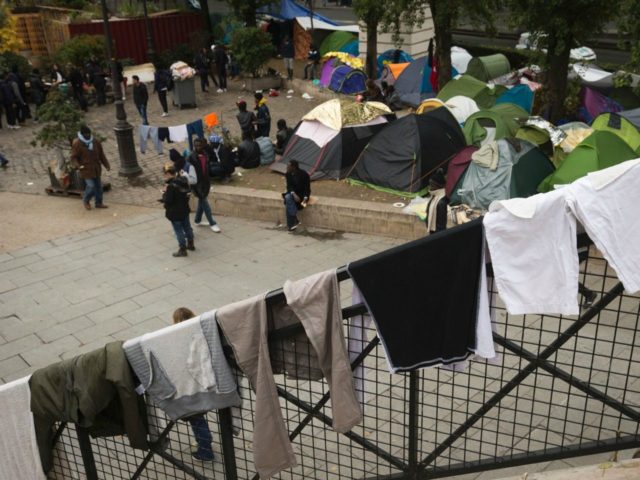Congressman Ellison has introduced several pieces of legislation that have never advanced.
Washington (CNN)Rep. Keith Ellison, the first Muslim elected to Congress and one of only two members in the Capitol, said Wednesday that in the wake of anti-Muslim rhetoric after the Paris attacks, Muslims are feeling a need to assert even more how patriotic they are.
The Minnesota Democrat said when he hears other lawmakers suggesting Christian Syrian refugees should be allowed into the country but Muslim Syrian refugees should not, it reminds him that the First Amendment to the Constitution establishes freedom of religion. More here.
Who is Keith Ellison? Left-wing congressman with past ties to Nation of Islam wants DNC job
FNC: In an attempt to stave off a civil war in the ranks, Democratic leaders are scrambling to unite behind a candidate for the party’s chairmanship – and have landed for now on a Louis Farrakhan-linked congressman who once called for Dick Cheney’s impeachment and compared George W. Bush to Hitler.
Rep. Keith Ellison, D-Minn., the first Muslim elected to Congress and a leading progressive among House Democrats, already has picked up the backing of both the Democratic Party’s left – with support from Sens. Bernie Sanders and Elizabeth Warren – and its establishment, receiving endorsements from Senate leaders Chuck Schumer, D-N.Y., and retiring Harry Reid, D-Nev.
Ellison is firmly on the party’s left – he has a fax line in his office, but his website says they will not respond to faxes “for environmental reasons.” He backed Bernie Sanders during the primaries, even introducing him at the convention.
“Bernie sparked the beginning of a revolution y’all,” Ellison said at his address during the Democratic National Convention in Philadelphia. “Together we call for climate justice, racial justice, wage justice.”
Sanders has given strong backing to Ellison in return, sending out a fundraising email saying an Ellison-led Democratic Party that will stand up to Wall Street greed and corporate America is “the Democratic Party we need.”
Ellison is expected to formally announce his bid Monday. On Sunday, Ellison hinted he would run and said the party needs to focus on middle- and working-class Americans and less on donors.
“I love the donors and we thank them, but it has to be that the guys in the barber shop, the lady at the diner, the folks who are worried about whether that plant is going to close, they’ve got to be our focus,” he said on ABC’s “This Week.”
Some strategists feel this economic message is exactly what the party needs to reach out to white working-class voters who pulled the lever for Trump.
“You can’t stand up for middle-class families if you are so closely associated with Wall Street and I think that was the issue with Clinton, her ties to Goldman Sachs, and I think that’s shown by how much money we raised from Wall Street,” Brad Bannon, Democratic strategist and CEO of Bannon Communications Research, told FoxNews.com. “We have to become more oriented to working-class families if we’re going to survive and prosper, because we blew the industrial Midwest.”
However, Ellison’s past associations and comments may trouble more moderate voters.
Ellison’s 2006 run for his seat was plunged into controversy after the conservative PowerLineBlog.com found he had once identified with Farrakhan’s Nation of Islam and in 1998 was referring to himself as Keith X Ellison and Keith Ellison-Muhammed.
The Washington Post reported that Ellison had defended Farrakhan against accusations of anti-Semitism in 1989 and in 1990 had called affirmative action a “sneaky” form of compensation for slavery, calling instead for reparations.
When the controversy erupted in 2006, Ellison acknowledged he had worked with the group, but only for 18 months to help organize Farrakhan’s 1995 Million Man March. He distanced himself from both Farrakhan and the Nation of Islam, and said he hadn’t scruitinized the group’s anti-Semitic positions appropriately.
“They were and are anti-Semitic, and I should have come to that conclusion earlier than I did,” he said.
Yet it isn’t the only controversy for Ellison. In 2007, Ellison made a comparison between Bush and 9/11 to Hitler and the 1933 Reichstag fire.
“9/11 is the juggernaut in American history and it allows… it’s almost like, you know, the Reichstag fire,” Ellison said, according to a Daily Telegraph report at the time. “After the Reichstag was burned, they blamed the Communists for it, and it put the leader of that country [Hitler] in a position where he could basically have authority to do whatever he wanted.”
He later clarified that he did indeed believe that Usama bin Laden was responsible for the terror attacks. But it wasn’t the only controversy for Ellison in 2007, as he also backed a movement to impeach then-Vice President Dick Cheney over his alleged fabrication of intelligence about weapons of mass destruction in Iraq.
However, Bannon believes that Ellison’s Muslim heritage could be a boost not a burden, especially in light of Trump’s elevation Sunday of controversial Breitbart boss Steve Bannon to chief strategist.
“[Steve] Bannon propagates Muslim conspiracy theories,” Brad Bannon, who is not related to the Breitbart head, said. “Ellison is the perfect guy to counter that. Ellison is exactly what we need to prove we aren’t the party of hate and racism.”
Ellison would have competition for the job. Former DNC chairman and ex-presidential candidate Howard Dean has put his name in the running. Former Maryland Gov. Martin O’Malle
y also said he’s considering a run.








 JOEL SAGET/AFP/Getty
JOEL SAGET/AFP/Getty